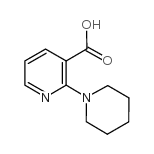2-piperidin-1-ylpyridine-3-carboxylic acid Suppliers
Total count: 1Updated Date: 2024-01-28 20:02:27

- China(Mainland)
- Contact: Yang
- Phone: 17521765436
- Email: sales@echemcloud.com
- Website: http://www.echemcloud.com
- Product Name: 2-piperidin-1-ylpyridine-3-carboxylic acid
- Updated Date: 2024-07-15 12:36:48
- Purity: 97.0%
- More information
Inquiry
2-piperidin-1-ylpyridine-3-carboxylic acid
- CAS Number: 78253-61-9
- Molecular Formula: C11H14N2O2
- Molecular Weight: 206.24100

Related product suppliers
Check more product suppliers